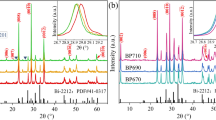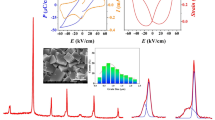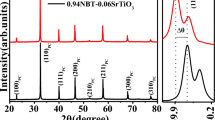Abstract
The effect of different molar ratios of Y2O3 and Y(NO3)3 on the microstructure and electrical response of ZnO-Bi2O3-based varistor ceramics sintered at 1 000 °C was investigated, and the mechanism by which this doping improves the electrical characteristics of ZnO-Bi2O3-based varistor ceramics was discussed. With increasing amounts of Y(NO3)3 or Y2O3 in the starting composition, Y2O3, Sb2O4 and Y-containing Bi-rich phase form, and the average grain size significantly decreases. The average grain size significantly decreases as the contents of rare earth compounds of Y(NO3)3 or Y2O3 increase. The maximum value of the nonlinear coefficient is found at 0.16% Y(NO3)3 or 0.02% Y2O3 (molar fraction) doped varistor ceramics, and there is an increase of 122% or 35% compared with the varistor ceramics without Y(NO3)3 or Y2O3. The threshold voltage V T of Y(NO3)3 and Y2O3 reaches at 1 460 V/mm and 1 035 V/mm, respectively. The results also show that varistor sample doped with Y(NO3)3 has a remarkably more homogeneous and denser microstructure in comparison to the sample doped with Y2O3.
Similar content being viewed by others
References
DURAN P, CAPEL F, TARTAJ J, MOURE C. Low-temperature fully dense and electrical properties of doped-ZnO varistors by a polymerized complex method [J]. Journal of the European Ceramic Society, 2002, 22(1): 67–77.
XU Dong, CHENG Xiao-nong, YUAN Hong-ming, YANG Juan, LIN Yuan-hua. Microstructure and electrical properties of Y(NO3)3·6H2O-doped ZnO-Bi2O3-based varistor ceramics [J]. Journal of Alloys and Compounds, 2011, 509(38): 9312–9317.
WU Zhen-hong, FANG Jian-hui, XU Dong, ZHONG Qing-dong, SHI Li-yi. Effect of SiO2 addition on the microstructure and electrical properties of ZnO-based varistors [J]. International Journal of Minerals, Metallurgy and Materials, 2010, 17(1): 86–91.
XU Dong, CHENG Xiao-nong, ZHAO Guo-ping, YANG Juan, SHI Li-yi. Microstructure and electrical properties of Sc2O3-doped ZnO-Bi2O3-based varistor ceramics [J]. Ceramics International, 2011, 37(3): 701–706.
XU Dong, SHI Li-yi, WU Zhen-hong, ZHONG Qing-dong, WU Xin-xin. Microstructure and electrical properties of ZnO-Bi2O3-based varistor ceramics by different sintering processes [J]. Journal of the European Ceramic Society, 2009, 29(9): 1789–1794.
XU Dong, CHENG Xiao-nong, YAN Xue-hua, XU Hong-xing, SHI Li-yi. Sintering process as relevant parameter for Bi2O3 vaporization from ZnO-Bi2O3-based varistor ceramics [J]. Transactions of Nonferrous Metals Society of China, 2009, 19(6): 1526–1532.
XU Dong, SHI Xiao-feng, CHENG Xiao-nong, YANG Juan, FAN Yue-e, YUAN Hong-ming, SHI Li-yi. Microstructure and electrical properties of Lu2O3-doped ZnO-Bi2O3-based varistor ceramics [J]. Transactions of Nonferrous Metals Society of China, 2010, 20(12): 2303–2308.
BERNIK S, MACEK S, BUI A. The characteristics of ZnO-Bi2O3-based varistor ceramics doped with Y2O3 and varying amounts of Sb2O3 [J]. Journal of the European Ceramic Society, 2004, 24(6): 1195–1198.
NAHM C W. Effect of cooling rate on degradation characteristics of ZnO·Pr6O11·CoO·Cr2O3·Y2O3-based varistors [J]. Solid State Communications, 2004, 132(3/4): 213–218.
PARK J S, HAN Y H, CHOI K H. Effects of Y2O3 on the microstructure and electrical properties of Pr-ZnO varistors [J]. Journal of Materials Science: Materials in Electronics, 2005, 16(4): 215–219.
HOUABES M, METZ R. Rare earth oxides effects on both the threshold voltage and energy absorption capability of ZnO varistors [J]. Ceramics International, 2007, 33(7): 1191–1197.
BERNIK S, MACEK S, AI B. Microstructural and electrical characteristics of Y2O3-doped ZnO-Bi2O3-based varistor ceramics [J]. Journal of the European Ceramic Society, 2001, 21(10/11): 1875–1878.
LIU J, HU J, HE J L, LIN Y H, LONG W C. Microstructures and characteristics of deep trap levels in ZnO varistors doped with Y2O3 [J]. Science in China Series E: Technological Sciences, 2009, 52(12): 3668–3673.
XU Dong, SHI Li-yi, WU Xin-xin, ZHONG Qing-dong. Microstructure and electrical properties of Y2O3-doped ZnO-Bi2O3-based varistor ceramics [J]. High Voltage Engineering, 2009, 35(9): 2366–2370.
GUNAY V, GELECEK-SULAN O, OZKAN O T. Grain growth kinetic in xCoO-6wt.% Bi2O3-(94-x) ZnO (x=0, 2, 4) ceramic system [J]. Ceramics International, 2004, 30(1): 105–110.
ONREABROY W, SIRIKULRAT N, BROWN A P, HAMMOND C, MILNE S J. Properties and intergranular phase analysis of a ZnO-CoO-Bi2O3 varistor [J]. Solid State Ionics, 2006, 177(3/4): 411–420.
XU Dong, TANG Dong-mei, LIN Yuan-hua, JIAO Lei, ZHAO Guo-ping, CHENG Xiao-nong. Influence of Yb2O3 doping on microstructural and electrical properties of ZnO-Bi2O3-based varistor ceramics [J]. Journal of Central South University, 2012, 19(6): 1497–1502.
BERNIK S, DANEU N. Characteristics of ZnO-based varistor ceramics doped with Al2O3 [J]. Journal of the European Ceramic Society, 2007, 27(10): 3161–3170.
LEACH C, LING Z, FREER R. The effect of sintering temperature variations on the development of electrically active interfaces in zinc oxide based varistors [J]. Journal of the European Ceramic Society, 2000, 20(16): 2759–2765.
PEITEADO M, FERNANDEZ J F, CABALLERO A C. Varistors based in the ZnO-Bi2O3 system: Microstructure control and properties [J]. Journal of the European Ceramic Society, 2007, 27(13/14/15): 3867–3872.
HE Jin-liang, HU Jun, LIN Yuan-hua. ZnO varistors with high voltage gradient and low leakage current by doping rare-earth oxide [J]. Science in China Series E: Technological Sciences, 2008, 51(6): 693–701.
NAHM C W, PARK C H. Microstructure, electrical properties, and degradation behavior of praseodymium oxides-based zinc oxide varistors doped with Y2O3 [J]. Journal of Materials Science, 2000, 35(12): 3037–3042.
CLARKE D R. Varistor ceramics [J]. Journal of the American Ceramic Society, 1999, 82(3): 485–502.
BUENO P R, VARELA J A, LONGO E. SnO2, ZnO and related polycrystalline compound semiconductors: An overview and review on the voltage-dependent resistance (non-ohmic) feature [J]. Journal of the European Ceramic Society, 2008, 28(3): 505–529.
NAHM C W. The preparation of a ZnO varistor doped with and its properties [J]. Solid State Communications, 2009, 149(19/20): 795–798.
BERNIK S, BRANKOVIC G, RUSTJA S, ZUNIC M, PODLOGAR M, BRANKOVIC Z. Microstructural and compositional aspects of ZnO-based varistor ceramics prepared by direct mixing of the constituent phases and high-energy milling [J]. Ceramics International, 2008, 34(6): 1495–1502.
NAHM C W. Effect of sintering temperature on nonlinear electrical properties and stability against DC accelerated aging stress of (CoO, Cr2O3, La2O3)-doped ZnO-Pr6O11-based varistors [J]. Materials Letters, 2006, 60(28): 3311–3314.
Author information
Authors and Affiliations
Corresponding author
Additional information
Foundation item: Project(BK2011243) supported by the Natural Science Foundation of Jiangsu Province, China; Project(EIPE11204) supported by the State Key Laboratory of Electrical Insulation and Power Equipment, China; Project(KF201104) supported by the State Key Laboratory of New Ceramic and Fine Processing, China; Project(KFJJ201105) supported by the Opening Program of State key Laboratory of Electronic Thin Films and Integrated Devices, China; Project(2011-22) supported by the State Key Laboratory of Inorganic Synthesis and Preparative Chemistry of Jilin University, China; Project(10KJD430002) supported by the Universities Natural Science Research Project of Jiangsu Province, China; Project(11JDG084) supported by the Research Foundation of Jiangsu University, China
Rights and permissions
About this article
Cite this article
Xu, D., Tang, Dm., Jiao, L. et al. Comparative characteristics of yttrium oxide and yttrium nitric acid doping in ZnO varistor ceramics. J. Cent. South Univ. 19, 2094–2100 (2012). https://doi.org/10.1007/s11771-012-1250-8
Received:
Accepted:
Published:
Issue Date:
DOI: https://doi.org/10.1007/s11771-012-1250-8




